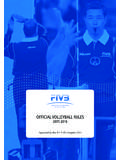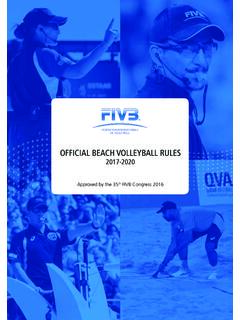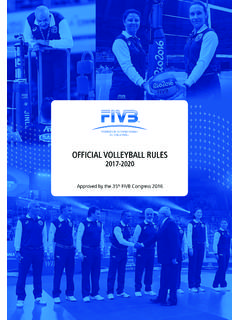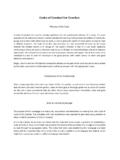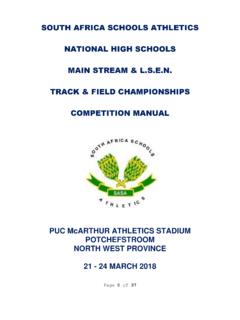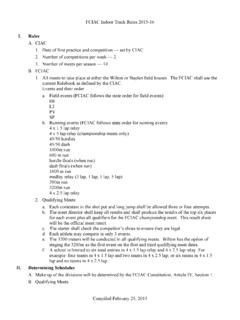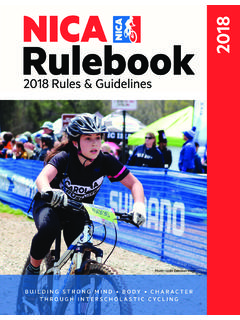Transcription of OFFICIAL VOLLEYBALL RULES
1 OFFICIAL VOLLEYBALL RULES . 2017-2020. Approved by the 35th FIVB Congress 2016. OFFICIAL VOLLEYBALL RULES 2017-2020. Published by FIVB in 2016 Design and layout: Samuel Chesaux Illustrations: FIVB 2014. OFFICIAL VOLLEYBALL RULES . 2017-2020. Approved by the 35th FIVB Congress 2016. To be implemented in all competitions beginning after 1st January 2017. OFFICIAL VOLLEYBALL RULES 2017-2020 1. CONTENTS. GAME CHARACTERISTICS 7. PART 1: PHILOSOPHY OF RULES AND REFEREEING 8. PART 2 - SECTION 1: GAME 11. CHAPTER 1: FACILITIES AND EQUIPMENT 12. 1 PLAYING PLAYING LINES ON THE ZONES AND 2 NET AND HEIGHT OF THE SIDE ADDITIONAL 3 UNIFORMITY OF FIVE-BALL CHAPTER 2: PARTICIPANTS 17. 4 TEAM LOCATION OF THE CHANGE OF FORBIDDEN 5 TEAM ASSISTANT 2. CHAPTER 3: PLAYING FORMAT 22. 6 TO SCORE A POINT, TO WIN A SET AND THE TO SCORE A TO WIN A TO WIN THE DEFAULT AND INCOMPLETE 7 STRUCTURE OF THE OFFICIAL WARM-UP TEAM STARTING POSITIONAL ROTATIONAL CHAPTER 4: PLAYING ACTIONS 27.
2 8 STATES OF BALL IN BALL OUT OF BALL IN ..27. BALL OUT ..27. 9 PLAYING THE 28. TEAM CHARACTERISTICS OF THE FAULTS IN PLAYING THE 10 BALL AT THE BALL CROSSING THE BALL TOUCHING THE BALL IN THE 11 PLAYER AT THE REACHING BEYOND THE PENETRATION UNDER THE CONTACT WITH THE PLAYER'S FAULTS AT THE 12 FIRST SERVICE IN A SERVICE AUTHORIZATION OF THE EXECUTION OF THE OFFICIAL VOLLEYBALL RULES 2017-2020 3. FAULTS MADE DURING THE SERVING FAULTS AND POSITIONAL 13 ATTACK CHARACTERISTICS OF THE ATTACK RESTRICTIONS OF THE ATTACK FAULTS OF THE ATTACK 14 BLOCK BLOCKING WITHIN THE OPPONENT'S BLOCK AND TEAM BLOCKING THE BLOCKING CHAPTER 5: INTERRUPTIONS, DELAYS AND INTERVALS 36. 15 NUMBER OF REGULAR GAME SEQUENCE OF REGULAR GAME REQUEST FOR REGULAR GAME TIME-OUTS AND TECHNICAL LIMITATION OF EXCEPTIONAL SUBSTITUTION FOR EXPULSION OR ILLEGAL SUBSTITUTION IMPROPER 16 GAME TYPES OF DELAY 17 EXCEPTIONAL GAME 40. INJURY / EXTERNAL PROLONGED 18 INTERVALS AND CHANGE OF CHANGE OF 4.
3 CHAPTER 6: THE LIBERO PLAYER 42. 19 THE LIBERO DESIGNATION OF THE ACTIONS INVOLVING THE RE-DESIGNATION OF A NEW CHAPTER 7: PARTICIPANTS' CONDUCT 46. 20 REQUIREMENTS OF SPORTSMANLIKE FAIR 21 MISCONDUCT AND ITS MINOR MISCONDUCT LEADING TO SANCTION APPLICATION OF MISCONDUCT MISCONDUCT BEFORE AND BETWEEN SUMMARY OF MISCONDUCT AND CARDS PART 2 - SECTION 2: THE REFEREES, THEIR RESPONSIBILITIES AND OFFICIAL HAND SIGNALS 49. CHAPTER 8: REFEREES 50. 22 REFEREEING CORPS AND 23 1st 24 2nd 25 OFFICIAL VOLLEYBALL RULES 2017-2020 5. 26 ASSISTANT 27 LINE 28 OFFICIAL REFEREES' HAND LINE JUDGES' FLAG PART 2 - SECTION 3: DIAGRAMS 59. D1a COMPETITION / CONTROL D1b THE PLAYING D2 THE PLAYING D3 DESIGN OF THE D4 POSITION OF D5a BALL CROSSING THE VERTICAL PLANE OF THE NET TO THE OPPONENT D5b BALL CROSSING THE VERTICAL PLANE TO THE OPPONENT FREE D6 COLLECTIVE D7 COMPLETED D8 BACK ROW PLAYER'S D9 WARNINGS AND SANCTIONS SCALES AND THEIR D9a MISCONDUCT WARNINGS AND D9b DELAY WARNINGS AND D10 LOCATION OF THE REFEREEING CORPS AND THEIR D11 REFEREES' OFFICIAL HAND D12 LINE JUDGES' OFFICIAL FLAG PART 3: DEFINITIONS 80.
4 INDEX 83. 6. GAME CHARACTERISTICS. VOLLEYBALL is a sport played by two teams on a playing court divided by a net. There are different versions available for specific circumstances in order to offer the versatility of the game to everyone. The object of the game is to send the ball over the net in order to ground it on the opponent's court, and to prevent the same effort by the opponent. The team has three hits for returning the ball (in addition to the block contact). The ball is put in play with a service: hit by the server over the net to the opponents. The rally continues until the ball is grounded on the playing court, goes out or a team fails to return it properly. In VOLLEYBALL , the team winning a rally scores a point (Rally Point System). When the receiving team wins a rally, it gains a point and the right to serve, and its players rotate one position clockwise. OFFICIAL VOLLEYBALL RULES 2017-2020 7. PART 1. PHILOSOPHY OF RULES . AND REFEREEING.
5 8. PART 1: PHILOSOPHY OF RULES AND REFEREEING. INTRODUCTION. VOLLEYBALL is one of the most successful and popular competitive and recreational sports in the world. It is fast, it is exciting and the action is explosive. Yet VOLLEYBALL comprises several crucial overlapping elements whose complimentary interactions render it unique amongst rally games. VOLLEY. Service Rotation PASSING. Explosive Jumping Power Action DIVIDED. Attack TEAM GAME Defense COURTS. In recent years the FIVB has made great strides in adapting the game to a modern audience. This text is aimed at a broad VOLLEYBALL public players, coaches, referees, spectators, commentators . for the following reasons: understanding the RULES better, allows better play coaches can create better team structure and tactics, allowing players full rein to display their skills;. understanding the relationship between RULES allows officials to make better decisions. This introduction at first focuses on VOLLEYBALL as a competitive sport, before setting out to identify the main qualities required for successful refereeing.
6 VOLLEYBALL IS A COMPETITIVE SPORT. Competition taps latent strengths. It exhibits the best of ability, spirit, creativity and aesthetics. The RULES are structured to allow all of these qualities. With a few exceptions, VOLLEYBALL allows all players to operate both at the net (in attack) and in the back of the court (to defend or serve). William Morgan, the game's creator, would still recognize it because VOLLEYBALL has retained certain distinctive and essential elements over the years. Some of these it shares with other net/ball/. racquet games: Service Rotation (taking turns to serve). Attack Defense VOLLEYBALL is, however, unique amongst net games in insisting that the ball is in constant flight a flying ball and by allowing each team a degree of internal passing before the ball must be returned to the opponents. The introduction of a specialist defensive player the Libero has moved the game forward in OFFICIAL VOLLEYBALL RULES 2017-2020 9.
7 Terms of rally length and multi-phase play. Modifications to the service rule have changed the act of service from simply a means of putting the ball in play to an offensive weapon. The concept of rotation is entrenched to allow for all-round athletes. The RULES on player positions must permit teams to have flexibility and to create interesting developments in tactics. Competitors use this framework to contest techniques, tactics and power. The framework also allows players a freedom of expression to enthuse spectators and viewers. And the image of VOLLEYBALL is increasingly a good one. THE REFEREE WITHIN THIS FRAMEWORK. The essence of a good OFFICIAL lies in the concept of fairness and consistency: to be fair to every participant, to be viewed as fair by the spectators. This demands a huge element of trust the referee must be trusted to allow the players to entertain: by being accurate in his/her judgement;. by understanding why the rule is written.
8 By being an efficient organizer;. by allowing the competition to flow and by directing it to a conclusion;. by being an educator using the RULES to penalise the unfair or admonish the impolite;. by promoting the game that is, by allowing the spectacular elements in the game to shine and the best players to do what they do best: entertain the public. Finally we can say that a good referee will use the RULES to make the competition a fulfilling experience for all concerned. To those who have read thus far, view the RULES which follow as the current state of development of a great game, but keep in mind why these preceding few paragraphs may be of equal importance to you in your own position within the sport. Get involved ! Keep the ball flying ! 10. PART 2. SECTION 1: GAME. OFFICIAL VOLLEYBALL RULES 2017-2020 11. CHAPTER 1. FACILITIES AND EQUIPMENT. See RULES 1 PLAYING AREA. The playing area includes the playing court and the free zone. It shall be , D1a, D1b rectangular and symmetrical.
9 DIMENSIONS D2. The playing court is a rectangle measuring 18 x 9 m, surrounded by a free zone which is a minimum of 3 m wide on all sides. The free playing space is the space above the playing area which is free from any obstructions. The free playing space shall measure a minimum of 7 m in height from the playing surface. For FIVB, World and OFFICIAL Competitions, the free zone shall measure 5 m from the side lines and m from the end lines. The free playing space shall measure a minimum of m in height from the playing surface. PLAYING SURFACE. The surface must be flat, horizontal and uniform. It must not present any danger of injury to the players. It is forbidden to play on rough or slippery surfaces. For FIVB, World and OFFICIAL Competitions, only a wooden or synthetic surface is allowed. Any surface must be previously approved by the FIVB. On indoor courts the surface of the playing court must be of a light colour. For FIVB, World and OFFICIAL Competitions, white colours are , required for the lines.
10 Other colours, different from each other, are required for the playing court and the free zone. On outdoor courts a slope of 5 mm per metre is allowed for drainage. Court lines made of solid materials are forbidden. 12. PART 2 - SECTION 1: GAME. LINES ON THE COURT D2. All lines are 5 cm wide. They must be of a light colour which is different from the colour of the floor and from any other lines. Boundary lines Two side lines and two end lines mark the playing court. Both side lines and end lines are drawn inside the dimensions of the playing court. Centre line The axis of the centre line divides the playing court into two equal D2. courts measuring 9 x 9 m each; however the entire width of the line is considered to belong to both courts equally. This line extends beneath the net from side line to side line. Attack line On each court, an attack line, whose rear edge is drawn 3 m back from , the axis of the centre line, marks the front zone. For FIVB, World and OFFICIAL Competitions, the attack line is D2.
